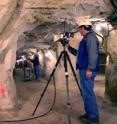Emergency links: NIST identifies 'sweet spot' for radios in tunnels
As part of a project to improve wireless communications for emergency responders, researchers at the National Institute of Standards and Technology (NIST) have confirmed that underground tunnels—generally a difficult setting for radios—can have a frequency “sweet spot” at which signals may travel several times farther than at other frequencies. The finding, which uses extensive new data to confirm models developed in the 1970s, may point to strategies for enhancing rescue communications in subways and mines. The optimal frequency depends on the dimensions of the tunnel. For a typical subway-sized tunnel, the sweet spot is found in the frequency range 400 megahertz (MHz) to 1 gigahertz (GHz). This effect is described in one of two new NIST publications.* The reports are part of a NIST series contributing to the first comprehensive public data collection on radio transmissions in large buildings and structures. Historically, companies have designed radios based on proprietary tests. The NIST data will support the development of open standards for design of optimal systems, especially for emergency responders.
NIST researchers were surprised by how much farther signals at the optimal frequency traveled in above-ground building corridors, as well as underground. Tunnels can channel radio signals in the right frequency range because they act like giant waveguides, the pipelike channels that confine and direct microwaves on integrated circuit wafers, and in antenna feed systems and optical fibers. The channel shape reduces the losses caused when signals are absorbed or scattered by structural features. The waveguide effect depends on a tunnel’s width, height, surface material and roughness, and the flatness of the floor as well as the signal frequency. NIST authors found good agreement between their measured data and theoretical models, leading to the conclusion that the waveguide effect plays a significant role in radio transmissions in tunnels.
Lead author Kate Remley notes that the results may help design wireless systems that improve control of, for example, search and rescue robots in subways. Some handheld radios used by emergency responders for voice communications already operate within the optimal range for a typical subway, between around 400 MHz and 800 MHz. To provide the broadband data transfer capability desired for search and rescue with video (a bandwidth of at least 1 MHz), a regulatory change would be needed, Remley says.
Source: National Institute of Standards and Technology (NIST)
Other sources
- Emergency Links: Researchers Identify 'Sweet Spot' for Radios in Tunnelsfrom Newswise - ScinewsTue, 13 May 2008, 21:28:07 UTC
